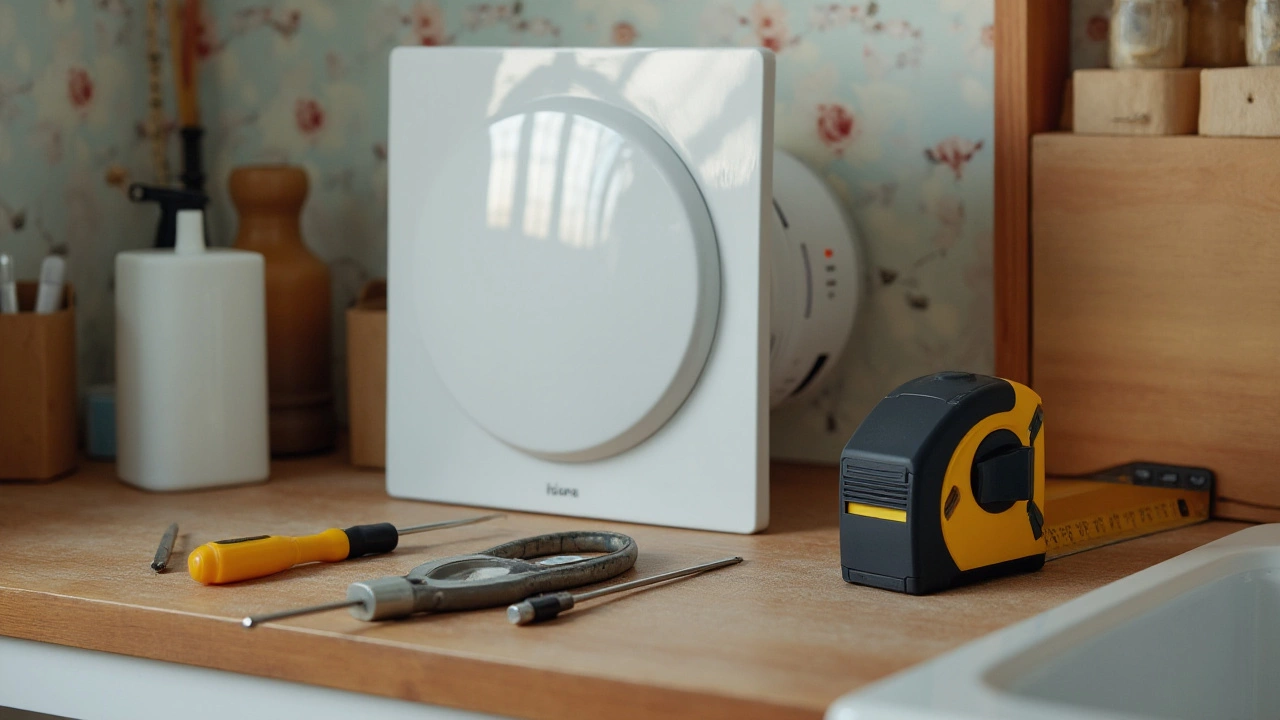Extractor fans play a vital role in maintaining indoor air quality by removing moisture, odors, and other pollutants from your home. Whether it's in the kitchen, bathroom, or laundry, these devices work tirelessly to ensure a comfortable environment. But what happens when they break down or lose efficiency?
The prospect of replacing an extractor fan might seem overwhelming, especially if you're not a seasoned DIY enthusiast. However, with the right guidance, the task becomes quite manageable. This guide is crafted to assist you through the process step by step, demystifying what might initially appear to be a complex job.
We'll explore what you need to know about these indispensable home appliances, how to judge if a replacement is necessary, and what tools to have at the ready. Embark on this journey with confidence, armed with insights and tips that will make your home improvement project as smooth as possible.
- Understanding Extractor Fans
- Assessing the Need for Replacement
- Gathering Tools and Materials
- Step-by-Step Replacement Process
- Tips for Efficient Replacement
Understanding Extractor Fans
Extractor fans, sometimes referred to as exhaust fans, are essential fixtures in many homes, tasked with improving air quality by venting out unwanted odors, moisture, and smoke. These fans are commonly installed in places like kitchens and bathrooms where excess moisture or fumes can accumulate. A working extractor fan ensures that your living space remains fresh and free from dampness, which can lead to mold growth, unpleasant smells, and even structural damage over time. Of note is the fact that modern extractor fans are equipped with enhanced features such as humidity sensors and variable speed settings, catering to specific ventilation needs.
Not all extractor fans are created equal; they vary in terms of size, power, and installation methods. Generally, the choice of an extractor fan depends on the size of the room and the volume of air that needs to be circulated. Fans are rated by their capacity to move air, measured in cubic meters per hour (m³/h) or cubic feet per minute (CFM). A kitchen extractor fan, for instance, may require a higher capacity than one used in a bathroom due to the amount of smoke and grease typically present. The type of extractor fan you may need can also vary, with options such as wall-mounted, ceiling-mounted, and in-line models, each providing its own benefits and installation challenges.
In exploring the mechanics of these essential devices, it’s worth understanding their dual functions: extraction and filtration. Most units are designed to extract air directly outside, but some use filters to clean the air internally before circulating it back inside the room. These recirculating fans are usually easier to install, as they do not require ductwork. However, extraction models are generally more effective in removing high levels of moisture and pollutants. Interestingly, the technology surrounding extractor fans is ever progressing. An example includes the advent of brushless DC motors that operate quieter and consume less power.
"A quiet and efficient extractor fan can significantly enhance indoor comfort and safety, particularly in small or poorly ventilated spaces," stated a recent report from the Environmental Protection Agency.
When discussing maintenance, regular cleaning and filter replacement can aid in prolonging the lifespan of your extractor fan. It’s a good practice to clean the fan grills and surrounding areas more frequently if the fan is used in a greasy or dusty environment. The service life of these fans is generally long, but wear and tear can lead to diminished capacity. Issues like unusual noises, failure to vent air properly, or visible damage can be signs that a fan needs attention or replacement. Savvy homeowners understand these mechanics and adapt their practices accordingly, resulting in a system that runs effectively and efficiently.
Assessing the Need for Replacement
Before diving into the replacement process, it's crucial to determine whether your extractor fan truly necessitates a full replacement. This understanding can save both time and resources, making the entire endeavor more efficient and cost-effective. Many homeowners often ponder if their fan is just dirty or if there are more underlying issues. Several indicators might compel you to consider a replacement seriously.
Firstly, observe the performance of the fan. Over time, an extractor fan can lose its strength and efficiency. A fan that's no longer capable of expelling steam and odors might indicate a failing motor or extensive wear. When an extractor fan operates, it should maintain a steady and consistent airflow, which you can typically verify by testing the air pressure against a piece of paper held near the vent.
Another telltale sign is noise. An extractor fan that becomes excessively loud, producing grinding or rattling noises, often points towards mechanical failure. The heart of these fans—its motor—might be faltering, requiring a professional diagnosis or outright replacement. Sometimes, cleaning or lubricating might resolve such sounds, but these are usually temporary fixes for a deteriorating motor.
"A functional extractor fan is vital for maintaining air quality, and ignoring signs of wear could lead to more significant health concerns," remarks John Doe, a veteran electrician renowned for his expertise in home ventilation systems.
Additionally, consider age and energy consumption. Older fans generally lack the energy efficiency of modern models. If energy bills have unexpectedly soared, the old extract fan might be struggling to keep up with demands, drawing more power than necessary. With the advent of new technologies, manufacturers produce more efficient, quieter, and energy-conserving units, making replacement a worthwhile investment.
Conducting a Thorough Inspection
Engage in a thorough inspection. Remove the fan cover, inspecting for visible damage or obstructions. Dust and debris build-up could impede operation but addressing surface-level dirt doesn't resolve intrinsic mechanical issues. Inspect fans for broken blades or wear in the motor housing. Testing different speed settings might shed light on any abnormalities in motor function. If there’s inconsistency, it might be time for a replacement.
Beyond mechanical and energy considerations, ventilation capacity is critical. If household renovations—like adding bathrooms or kitchens—have taken place since installation, the existing extractor might not suffice for the new space. Newer areas may require stronger units to accommodate increased moisture or odor levels. Evaluating the overall ventilation efficiency helps keep indoor air fresh and healthy.
A proper assessment of these factors aids in making an informed decision about a fan's replacement. Understanding the extent of any issues, acknowledging the fan’s current capacity, and recognizing the benefits of new advancements guide this thoughtful evaluation process toward better home air quality management.

Gathering Tools and Materials
Embarking on the journey of replacing an extractor fan demands a well-thought-out plan, starting with collecting the necessary tools and materials. Having everything on hand before you begin not only streamlines the process but also curtails potential hiccups that could arise. Forethought in preparation lays the foundation for a seamless, efficient fan replacement.
Begin by considering what tools you'll need for this task. A standard toolkit suffices, containing essentials such as a screwdriver set, utility knife, plier, and wire stripper. Depending on the model of your extractor fan, you might also require a stud finder to locate beams for proper mounting. Many guides reiterate the importance of safety gear, noting that gloves and safety goggles should never be overlooked—these basic safety steps are key in preventing any unnecessary accidents.
Materials should not be left out of this initital planning phase. Beyond the fan replacement itself, check if additional wiring or ducting might be required. Some projects might necessitate new brackets or fittings, so it's worth checking compatibility between old and new components beforehand. Consider the fan's placement: are the dimensions the same, or will adjustments be needed to accommodate a new model? A little research can save immense time later.
Checklist of Tools and Materials
- Standard Screwdriver Set
- Utility Knife and Pliers
- Wire Stripper
- Stud Finder
- Gloves and Safety Goggles
- Replacement Wiring and Ducting (if needed)
- New Brackets or Fittings (as required)
This straightforward checklist aligns with advice found in many DIY improvement forums, where a consistent message emerges: "Measure twice, cut once." Following this adage can help prevent unnecessary trips to the hardware store, assisting in keeping the workflow smooth and uninterrupted. As experiences shared by enthusiasts reveal, preparation often makes up half of any successful project.
Step-by-Step Replacement Process
Replacing an extractor fan involves several stages, each demanding attention to detail and safety. Let's navigate this process, keeping utility and simplicity in focus. Begin with turning off the power supply to avoid any electrical mishaps. Locate the circuit breaker that controls the fan's power and switch it off completely. Confirm it's off by using an electrical tester—safety comes first, always.
Removing the Old Fan
Once safety protocols are in place, it's time to remove the panel covering the extractor fan. You'll typically find this held in place by screws, so keep a screwdriver handy. Carefully unscrew and set aside the panel. Now, examine how your old fan is connected. Disconnect the wiring, noting which wire connects where, as this will be crucial during installation. Parental notes can help here, as will taking a quick photo with your smartphone for reference.Preparing for Installation
Removing debris or dust accumulated in the duct is important for the new fan’s efficiency. Depending on your ductwork’s condition, a quick vacuum might be beneficial. At this point, assess whether any components need cleaning, repair, or even replacement. Measuring the opening is crucial—your new fan must fit well. If the dimensions don’t match, consider an adapter. Using a replacement fan with energy-efficient features isn't just a trend anymore; it’s becoming a necessity.Wiring the New Fan
Now's the moment to connect your new extractor fan. Refer to your prior notes or photos to ensure accuracy. Wire colors often play a crucial role; black or red usually indicates live, white neutral, and green or copper is typically the ground wire. Secure the connections using wire nuts to prevent any looseness. Double-check by gently tugging the wires. Once satisfied, mount the fan onto its bracket. Using a drill to drive screws securely isn't just recommended; it's essential to maintain longevity.Testing and Final Adjustments
With everything in place, restore power at the main breaker. A flip of the switch should bring your new fan humming to life. Listen for unusual noises that might indicate a connection issue or misalignment. Performance matters, so make sure the fan effectively dispels air—calculating the airflow based on the manufacturer's specifications will guide you.“Installation isn’t complete until performance meets or exceeds expectations,” says Rachel Hendricks, a renowned home improvement expert.Finally, reinstall the panel to give your space a polished finish. You've now achieved a milestone in home improvement with not just a new, but an optimized extractor fan!

Tips for Efficient Replacement
In the journey of replacing an extractor fan, coming prepared with a few strategic tips can make all the difference. For starters, understanding the exact model and type of your existing fan is crucial. This seemingly simple step can save a lot of time because each brand and model might have specific requirements for installation or removal. A lot of people tend to skip this, only to encounter problems later during the process. Matching the capacity and airflow of the new fan with the room size ensures optimal performance and energy efficiency, which is pivotal for spaces like kitchens and bathrooms where humidity and odors are prevalent.
Safety is paramount when working with electrical appliances. Before starting, always remember to turn off the power supply to avoid any potential electric shocks. Using a voltage tester can provide additional peace of mind by confirming the circuit isn’t live. Although this might sound unnecessary, it’s an important safety step that shouldn’t be overlooked. Gathering all necessary tools in advance, such as screwdrivers, pliers, and a drill, keeps the workflow smooth and prevents disruptions, proving to be not just a convenience but an efficiency booster. Moreover, having a helper can simplify the task significantly, ensuring that everything from holding the fan in place to passing the right tool becomes a seamless experience.
When buying a new fan, look for noise ratings. A quiet extractor fan can dramatically improve the comfort level of your home. It’s not just about function, but also about fitting into your home environment without being a constant source of irksome buzzing. As some industry experts have suggested, a fan with a lower sone rating is generally quieter, thus a better choice for noise-sensitive areas.
"Choosing the right fan is as much about noise level as it is about functionality," says home improvement expert, Richard Newland.Ensuring compatibility with your existing ductwork or vent system can be an often overlooked but significant aspect. Misalignment in connections not only makes installation difficult but can also impede the fan's performance and longevity.
During installation, often it's advisable to refer to the instruction manual provided by manufacturers, which contains tested and accurate guidance specific to your model. While many might rely on general advice or online videos, the manual ensures that you’re adhering to specifications intended for your fan, preventing errors and potential mishaps. In some cases, consulting with a professional might be worth considering, particularly when complex wiring is involved. This ensures not only a perfect fit but also compliance with local electrical codes, which are crucial to guarantee safety and legality of the installation.
Wrapping up the installation, it's important to test your new fan thoroughly. Turn it on and ensure that it adequately moves air out of the room. Use the occasion to listen for unexpected noise or vibration, which might suggest an incorrect installation. If things seem off, don’t hesitate to revisit the instructions or consult an expert. Remembering these tips can greatly enhance your experience, transforming what might seem like a daunting project into a gratifying home improvement success, all while ensuring your ventilation system contributes effectively to a healthier indoor environment.


